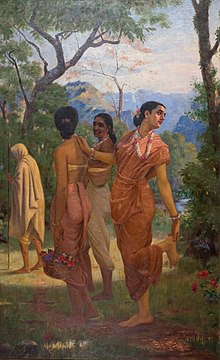
Back শকুন্তলা Assamese শকুন্তলা Bengali/Bangla Ŝakuntalo Esperanto Shakuntalá Spanish Shakuntala Basque شکونتلا Persian Shâkuntalâ French શકુંતલા Gujarati शकुन्तला (मेनका पुत्री) Hindi Sakuntala ID
| Shakuntala | |
|---|---|
 Shakuntala has inspired many artworks, including
Raja Ravi Varma's Shakuntala looking for Dushyanta, depicting her pretending thorn removal from feet while looking for Dushyanta. | |
| Personal Information | |
| Family | Vishvamitra (father) Menaka (mother) Kanva (adoptive father) |
| Spouse | Dushyanta |
| Children | Bharata |
Shakuntala (Sanskrit: शकुन्तला, romanized: Śakuntalā) is a heroine in ancient Indian literature, best known for her portrayal in the ancient Sanskrit play Abhijnanashakuntalam (The Recognition of Shakuntala), written by the classical poet Kalidasa in the 4th or 5th century CE. Her story, however, originates in the Hindu epic, the Mahabharata (c. 400 BCE - 400 CE), where she appears in the Adi Parva ("The Book of Beginnings"). In both narratives, Shakuntala is the daughter of the sage Vishwamitra and the celestial nymph Menaka. Abandoned at birth, she is raised by the sage Kanva in a forest hermitage. She later falls in love with King Dushyanta and becomes the mother of Bharata, a celebrated emperor of India.[1]
In the Mahabharata, Shakuntala and Dushyanta secretly get married through the gandharva tradition (love marriage) and consummate their marriage in her forest hermitage. When she later approaches him with their son Bharata, he hesitates to acknowledge them. Shakuntala rebukes him forcefully until a celestial voice confirms the truth, compelling Dushyanta to accept her and their son.
Abhijnanashakuntalam dramatizes the story with poetic elegance. In this version, after King Dushyanta departs from the hermitage, Shakuntala, lost in thoughts of him, fails to greet the irascible sage Durvasa, who curses her so that Dushyanta will forget her entirely. The curse can only be lifted if he sees a token of their love—a signet ring he had given her. The now-pregnant Shakuntala journeys to the palace, but she loses the ring in a river and is rejected by Dushyanta, who fails to recognise her. Humiliated and abandoned, she is lifted away by celestial beings to her divine mother Menaka’s abode. The lost ring is later found in a fish’s belly and returned to Dushyanta, restoring his memory. Overcome with remorse, he longs for Shakuntala, and in time, reunites with her—now with their son, Bharata.
Shakuntala has been a significant figure, often seen as a symbol of Indian womanhood, inspiring numerous literary, artistic, and visual adaptations.
- ^ "Shakuntala - the Epitome of Beauty, Patience and Virtue". Dolls of India. 16 September 2011. Retrieved 8 March 2016.